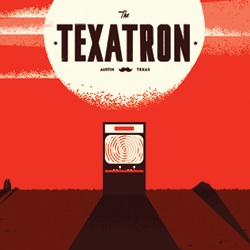GIMME ADVER GAME: COUNTING DOWN TO THE APOCALYPSE WITH 4 1/2 WEEKS TO SAVE THE WORLD
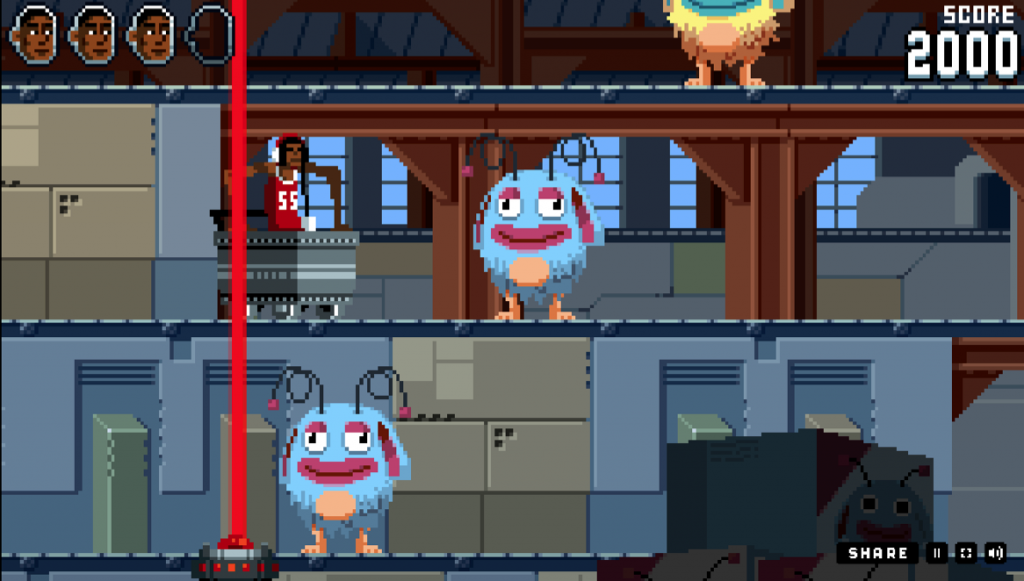
We may actually honestly be nearing end-times when an Old Spice adver-game is suddenly a very serious contender for November and December’s web-gaming-best, but here we are, and Dikembe Mutombo’s 4 1/2 Weeks to Save the World very easily could be.
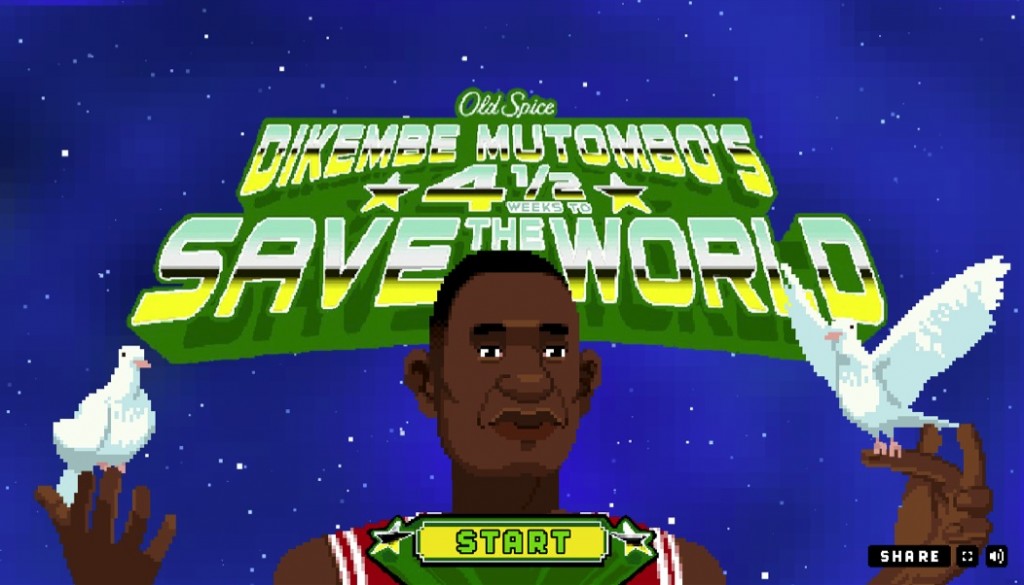
The idea might come as less of a shock when you consider the all-star team at the heart of it: Canabalt creator Adam Saltsman along with his Capsule cohort Robin Arnott, artist Paul Veer & musician Jukio ‘Kozilek‘ Kallio — both behind the other Venus Patrol-exclusive game, Gun Godz — and artist Sven ‘ptoing‘ Ruthner, best known (or maybe should-be-best-known) for his work on 2008 action-tunneler Thrustburst.
Working with ad agency Wieden & Kennedy, the team were tasked with coming up with a new, full mini-game every week straight through to the Mayan apocalypse, the second (and stronger of both so far) of which has launched today. Shown at top, it’s a multi-tiered mine-cart action game that doesn’t fall that far from the tree Saltsman & Veer planted for their Hunger Games movie tie-in Girl on Fire, and continues the overall initiative’s reliance on a steady-stream of non-sequitur jokes.
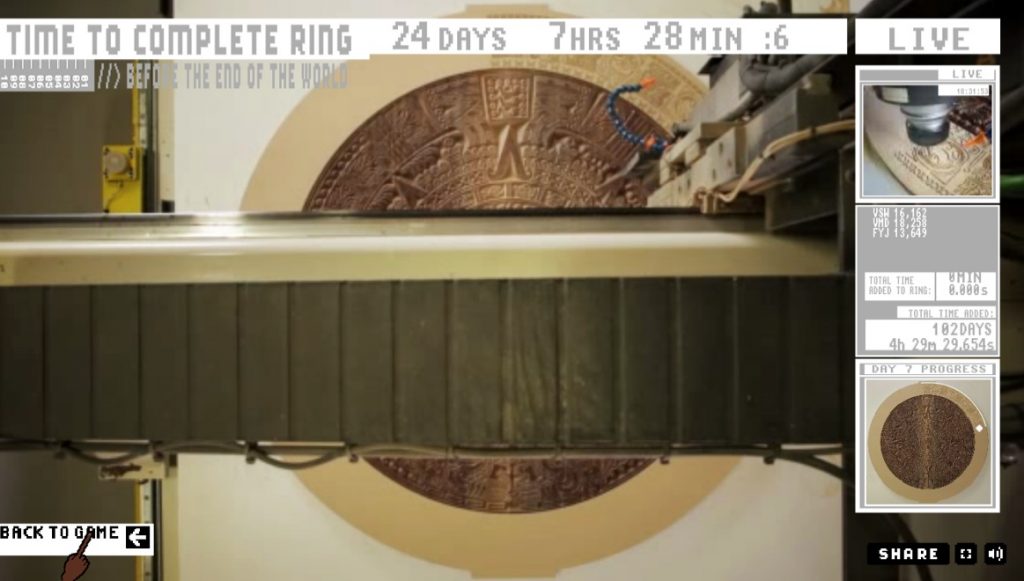
It’s those “no idea turned down” jokes that seem to be giving the project its vitality — between handing retired basketball champ and game-star Mutombo an insane script for him to deadpan his way through (with shades of the way TV cult-classic Fishing With John played with its own narrator) and the punch-drunk exhaustion that must come from providing a new, polished design every five days, the games have the same raw enthusiasm as any from a typical game jam.
Three more ‘current event’-ish games will be released up to the December 17th deadline, a countdown to which you can watch via the vaguely terrifying computer-aided Mayan calendar carving live-cam happening behind the scenes: play the first two now to make sure you’re caught up on the non-storyline as it develops.
See more posts about: Adam Saltsman, Dikembe Mutombo's 4 1/2 Weeks to Save the World, Gimme Indie Game, Kozilek, Paul Veer, Robin Arnott, Sven Ruthner
GIMME INDIE GAME: THE TURING-TEST CALISTHENICS OF CHRISTIAN SCHNELLMANN’S HUMAN AEROBICS
Even though I haven’t had a chance to play with another human, I’m more or less instantly crazy charmed by Christian ‘Reduktion‘ Schnellmann’s Human Aerobics, which there’s little other way to describe than a mashup between Dance Dance Revolution & Chris Hecker’s SpyParty.
The strictly 2-player game takes the latter’s “reverse Turing” mechanics, where one player tries to sniff out which is the human in a line-up of computer-controlled players, and sets it in a retro-jazzercize studio, where the other is frantically trying to keep their cool with a standard pattern-matching rhythm game.
It’s a dead-simple idea perfectly executed, and easily the week’s best free download — be sure to stop by his Reduktion site where he’s got many more beautiful art/games to explore, including Flight Simulator 0 (shown above), a goal-less iOS diversion that sees you piloting a paper plane through a near note-for-note replica of the low-poly landscape I’d always hoped someone would crib from Takuya Hosogane’s gorgeous motion-graphics piece Vanishing Point. [via IndieGames]
See more posts about: Christian Schnellman, Gimme Indie Game, Human Aerobics
GIMME INDIE GAME: THE IGNEOUS INSANITY OF DENKI’S SAVE THE DAY
A late contender for web game of the year squeaking in under the wire, but with an amazingly strong showing, comes Save The Day, from Scottish indies Denki, who you may recall as the creators of the fantastic strategy word game Quarrel (previously profiled here in 2009 and released this year for both XBLA and iOS), or even further back with the under-sung Game Boy Advance gem Go! Go! Beckham! (which is so much better than any David Beckham-license game has any right to be).
Save The Day‘s their debut for upstart HTML5 platform Turbulenz, and likely will serve as its new flagship title: a fantastically frenetic and compelling arcade game that gives you just minutes to pilot your rescue helicopter through a volcanic disaster, rescuing hapless citizens who, collectively, grant access to more perilous sections buried deeper within its world.
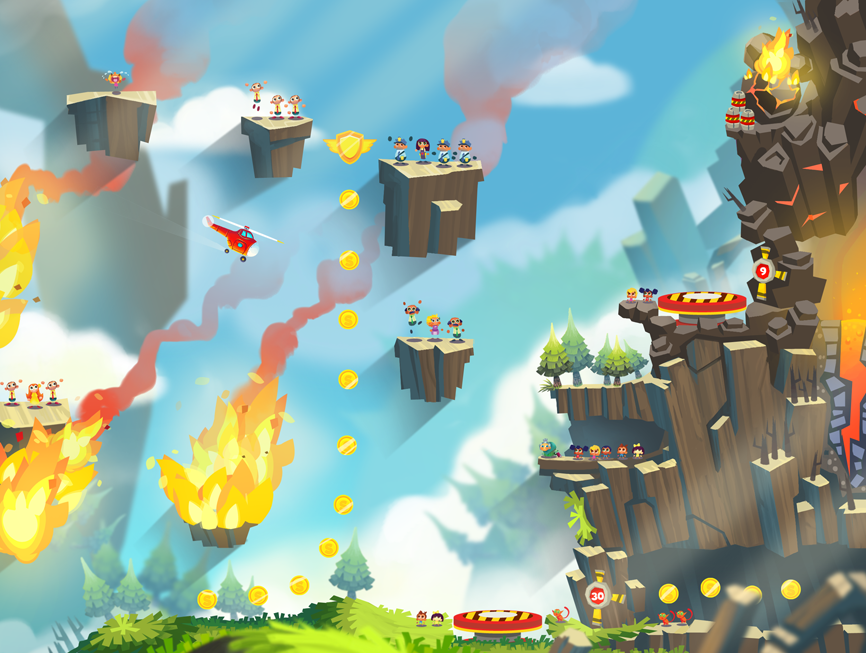
You’ll note traces of Choplifter, H.E.R.O. and maybe, more recently, PixelJunk Shooter, but what puts Save The Day over the top is its reliance on time & score, rather than environmental damage and enemy attack, and its constant blare of super satisfying information overload, that makes it a perfect, replayable three minute morsel.
Denki have confessed to but not elaborated on “grand plans for the game”, and it’s certainly something I wouldn’t mind being able to play away from the desk, but you’ll be very happy to have gotten in on the ground floor now by spending the rest of your day playing on Turbulenz right here.
See more posts about: Denki, Gimme Indie Game, Save The Day
VP REWIND: THE FRACTURED FRAMEWORK OF TWINBEARD’S FROG FRACTIONS
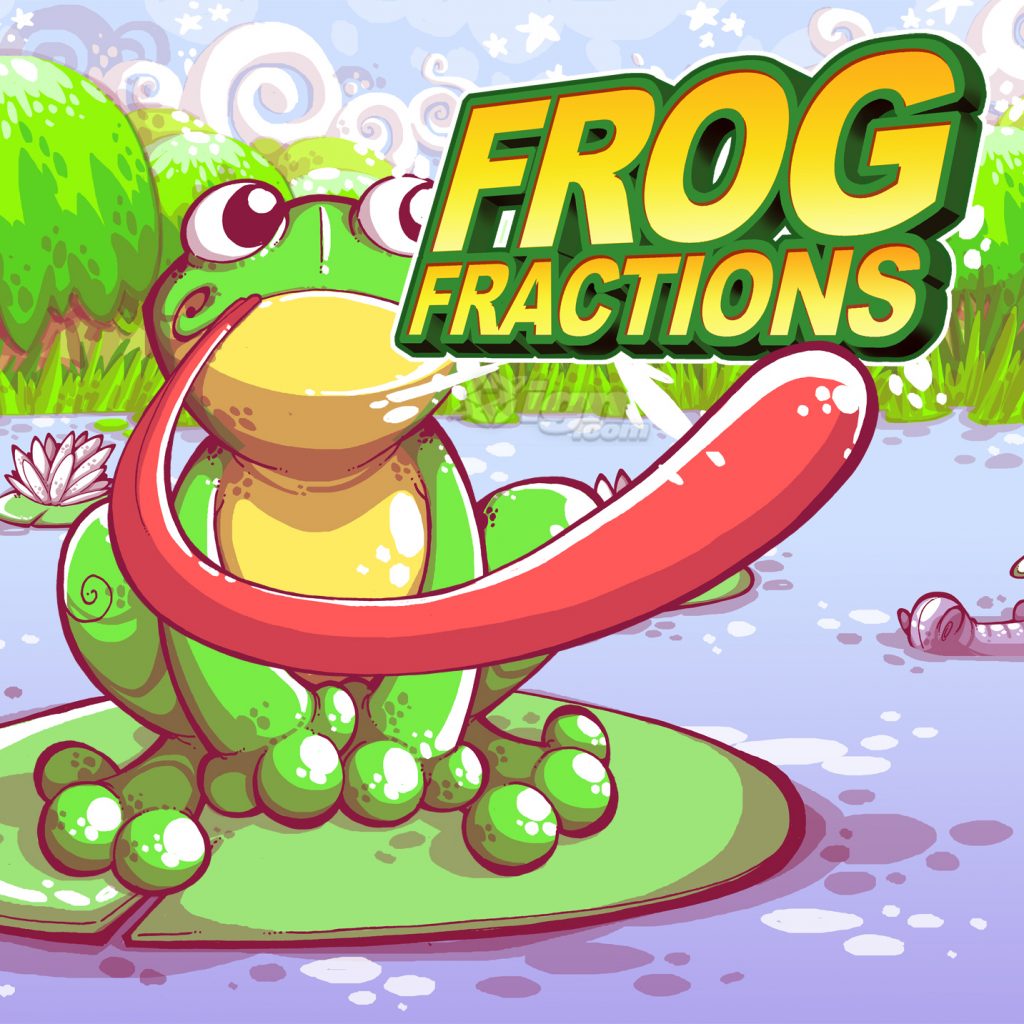
If there was one game that quietly dominated last week’s stay in Nottingham for GameCity7, it was one that, weirdly, wasn’t present at all, but rather was on everyone’s lips in all the downtime in between: Frog Fractions, the latest web game from Jim “Twinbeard” Crawford.
What was remarkable, though — or, at least, will be until you play the game yourself — was in how little anyone would bring themselves to say about the game, or how little anyone who’d already heard of the game but hadn’t had a chance to play it wanted anyone to tell them.
It was something like a sly wink or a secret handshake — people would only softly utter “have you played Frog Fractions yet?” and wait for the knowing smile back, both too afraid to pry further and spoil something either one might not have seen.
So consider this a sly wink of my own, and a light push to devote your next hour or two to Frog Fractions, if you haven’t already. You’ll be forgiven for that first wave of confusion as you wonder what’s so compelling about what at first glance seems like simple, sort-of precious edutainment parody, as the game then begins to unfurl layer after layer of straight up ideas.
See more posts about: Frog Fractions, Gimme Indie Game, Twinbeard
GIMME INDIE GAME: THE CRIME & PUNISHMENT OF EXOTWORKING’S THE VISIT
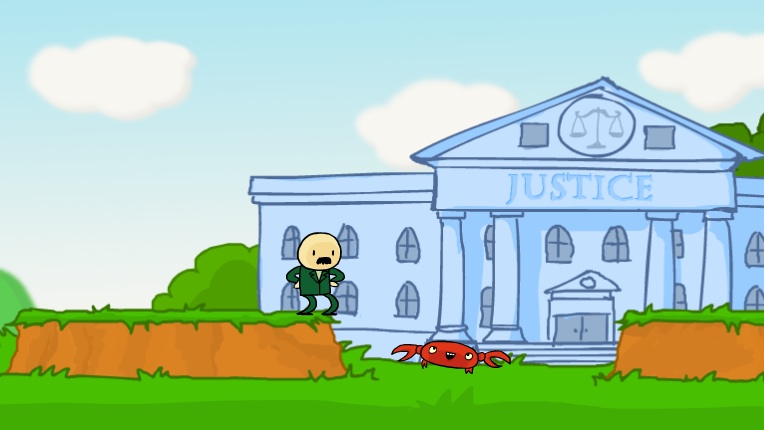
There’s sort of no better way to spend an hour or so of your Wednesday than with Exotworking‘s just-released game, The Visit, which, finally, fully considers — to all of its various logical conclusions — the ethics of retro-platformer sociopathy.
It’s a brief, perfect short-story of a game which initially formed out of a 48 hour jam, by Irina Gross, Benedikt Hummel, and Majus Fietzek, who you may recognize as the developer who landed himself a Double Fine internship by putting together a fully playable adventure game “application”.
Just as funny (if not as anarchist & severe) as TheCatamites’ Murder Dog, you’ll be finished with The Visit when you’ve branched out on all six punchline paths, only the three most obvious of which I’ve yet found, each as satisfying as the last — the best kind of mid-week distraction. [The Visit, via Tim Schafer]
See more posts about: Exotworking, Gimme Indie Game, The Visit
GIMME INDIE GAME: THE IMPROBABLE HISTORY OF THECATAMITES’ PLEASUREDROMES OF KUBLA KHAN
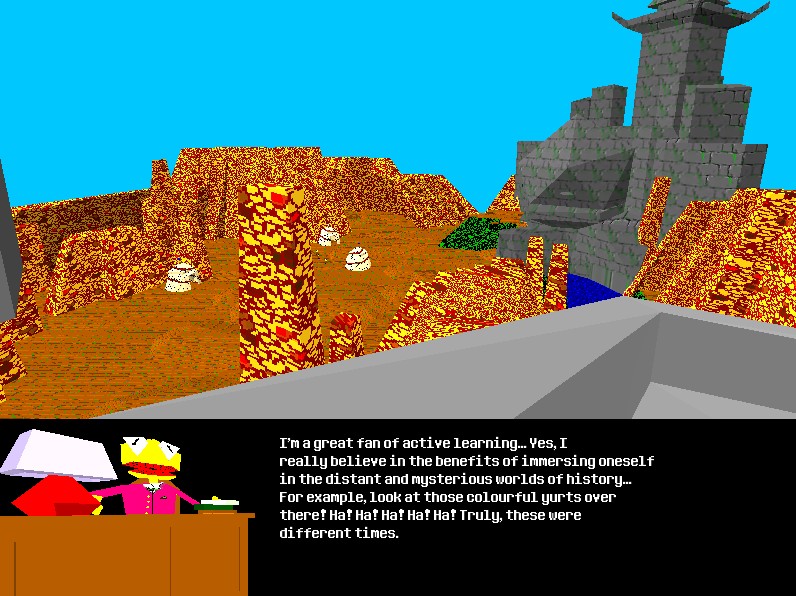
Already renowned amongst certain circles of the indie community, TheCatamites became even more an instant cult favorite developer with the release of last year’s anarcho-adventure Murder Dog IV: Trial of the Murder Dog, a short, brutal and deceptively brilliant and funny point & click game that went deep into the remorseless mind of a dog given over to his own raging and vengeful id (don’t miss the game’s trailer).
The Pleasuredromes of Kubla Khan, just released as a free PC download, continues right where Murder Dog left off: a brief but hilarious interactive history lesson of the Mongol emperor’s Xanadu.
Like a modern-day punk Encarta (and as with Murder Dog), its best feature is its frantic and entirely unreliable Muppet-esque narrator, providing meta-commentary on all your actions (toss yourself off the edge of the world to smash further through the fourth wall), as you find yourself headed straight into the hedonistic heart of the pleasuredrome.
The fact that the game has instantly crashed out at the peak of the insanity in every one of my playthroughs is, I hope, awesomely intentional, and puts the game high on my list of 2012’s greatest. [The Pleasuredromes of Kubla Khan, via GameJolt]
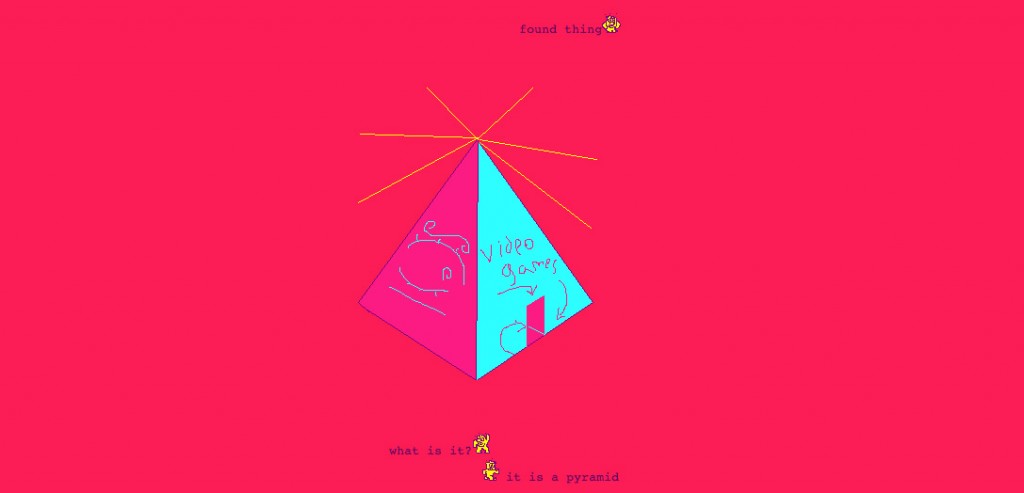
Still desperately missed on Twitter, TheCatamites has also just launched his new website Harmony Zone, where you can find all of his previous releases (see also especially: Space Funeral), as well as precious resources for would-be devs, and one of the best definitions of ‘game’ in recent memory. [via @doougle]
See more posts about: Gimme Indie Game, Murder Dog, TheCatamites
GIMME INDIE GAME: THE PSYCHO/SCHIZO PUZZLING OF MCMILLEN/GOOD/KARPEL’S TIME FCUK
I knew Time Fcuk was after my one true heart on hearing the first few melancholic melodica triplets in its title screen theme, which are nothing if not lovingly lifted from Carter Burwell’s score for the Coen Bros.’ Fargo, and perfectly peg the pathos that begins to unfold as you start your cyclical descent into the game’s world.
Created by No Quarter, Super Meat Boy, and Aether designer Edmund McMillen, programmer William Good and musician Justin Karpel — and described only via cryptically impenetrable blurbs — at its core, Time Fcuk is a fairly straightforward game to describe: it’s a block/switch/key puzzler with a twist of inter-dimensional-spatial-chronological tearing that rips you through layers of the same room you occupy.
What sets it apart, though, is the tone McMillen has set via an in-game one-way communicator that sees an unidentified narrator constantly interrupting your thought processes with ranting inanities, cries for help, and, eventually, more deeply unsettling and I.D.-confusing asides. And there’s this matter of the small growth coming from the back of your head…
The effect, if that narrator is you — and it certainly looks like you — echoes movies like the previously big-upped Timecrimes or basically pick any of your favorite schizo-persona David Lynch movies from Twin Peaks to Lost Highway to Mulholland Drive.
By being forced into “the box” from which you spend the game trying to escape (which you were pushed into by someone who claims to be you from some 20 minutes in the future) you come to realize that the interruptions more likely are echoes of every iteration of a loop in which you’re stuck: ‘you’s that have been through multiple times and no longer fear your surroundings, newer ‘you’s that haven’t yet figured out what’s happening. In the meantime, you — the you that’s playing — are acting out that transition from confusion to confidence by learning the puzzle-tricks that get you from one room to the next.
All of this is subtle subtext, and that’s precisely what makes Time Fcuk so affecting. Add to that its expertly devised level editor — which takes a page from Echochome‘s book and gives players a 20-level loop of random player-creations to rate for difficulty and fun, so that essentially no puzzle goes un-played — and the gang of three have created what is easily one of the best Flash games of the year thus far.
See more posts about: Gimme Indie Game, Offworld Originals
GIMME INDIE GAME: THE ONE BUTTON ACTION FILM OF ADAMATOMIC’S CANABALT
Ignore for just a few minutes the fact that there’s an already admittedly excellent stripped down Flash version of DICE’s Mirror’s Edge, because Canabalt — the just-released Experimental Gameplay entry from Fathom and Flixel creator Adam ‘Atomic‘ Saltsman and musician DannyB — strips that down even further, and better.
Consider it, maybe, the souped-up Tiger/Game & Watch LCD version of Mirror’s Edge, then: you have one goal, and one button, and the goal is to run, and the button is jump, and the game comes from simply maintaining breakneck momentum as you leap from rooftop to randomly generated rooftop.
Saltsman is an unabashed devotee of the Hollywood action flick, and the fact that his last recommendation was Peter O’Toole film The Stunt Man seemed somehow appropriate the instant you take your first dive through the game’s opening breakaway window. And then he moves on to John Woo, scattering a flock of doves skyward as you leap to the next roof, and then like take your pick from any sci-fi action/disaster as the first crashing alien ship rumbles past the screen, or you first notice the megalithic monsters trampling the far background.
For a five-day start-to-stop development it’s exceedingly confident and exceptionally accomplished: in keeping with the Experimental Gameplay’s ‘bare minimum’ theme, there’s a laundry list of things Saltsman could’ve added (I’m still not sure what my high score is from the 30-40 playthroughs today — I’m too busy compulsively slamming the retry button to take the half second to notice), but nothing he could have taken away, and it’s going to be quite some time before you find something so simple so thrilling again.
Canabalt [AdamAtomic, super-wide HD version for hi-res monitors]
See more posts about: Adamatomic, Gimme Indie Game, Offworld Originals
GIMME INDIE… SLICK, SOMETHING: ENVIRO-BEAR 2010 RELEASED FOR IPHONE
The day’s best indie surprise: Crackerblocks’ former Gimme Indie Game featured ‘cockpit’ game, Enviro-Bear 2000: Operation: Hibernation, has officially just now landed on the iPhone as Enviro-Bear 2010 [App Store] at a 99¢ pricepoint.
It comes recommended not only because creator Justin Smith quoted Offworld in his App Store product description, but because it’s actually a fair bit more playable on the device compared to its PC counterpart, with your car-control bits only a fingertip away, rather than a wildly flailing mouse-swipe away.
Case in point: out of the countless calamitous times I played the PC original, my first session on the iPhone was honestly the first time I’d reached level two. Bone up on the details of the game in its first writeup, then visit Smith’s page for more information on the new mobile version.
Enviro-Bear 2010 [Justin Smith, App Store link]
See more posts about: Gimme Indie Game, Offworld Originals
GIMME INDIE GAME: WORLD OF GOO, HENRY HATSWORTH DEVS DEBUT NEW GAMES AT EXPERIMENTAL GAMEPLAY PROJECT
Back in the hazy days of my stint at Edge Online — before indie gaming had truly become a movement, certainly one fought over by console manufacturers, a time when Cave Story was still just a twinkle in Pixel’s eye — there was only one place I knew I could trust to feed me reliably worthwhile new games: Carnegie Mellon’s Experimental Gameplay Project.
It was there that the dual Kyles (co-founders Gabler and Gray, of World of Goo and Henry Hatsworth renown, respectively) and their classmates laid the rapid prototyping foundation that would influence the indie scene at large (notably Petri Purho, who credits the technique for spawning his Crayon Physics).
Now, with Gabler still spinning up for 2D Boy’s sophomore effort, and Gray recently departing EA for indie work, the two have relaunched the site and will be serving new, monthly seven-day challenges, with the first three games of the debut challenge just premiered.
The first, seen at top, is Gray’s Frobot: Fueled by Dancing: a Robotron/Smash TV-esque keyboard/mouse-controlled shooter in which the titular ‘bot is tasked with conquering salarymen with the power of funk, morphing them instantly into a series of ‘solid-gold dancers’, with a nicely unfolding power-up structure.
The second, above right, is Proto Shooter, an entirely mouse controlled classic 8-bit pixel shooter from EGP newcomer and World of Goo Wii programmer Allan Blomquist, and finally, below, is Gabler’s Egg Worm Generator.
Technically not at all a game (and apparently salvaged from a failed attempt at a Karl Sims-inspired evolutionary shooter), Egg Worm is a generative Darwinian simulation in which creatures are given one minute to live and crawl to the right toward a green pixel. Any creature that doesn’t make it is scrapped, any survivors breed their traits further and slowly grow more adept at walking rightward, a transformation surprisingly compelling to observe over time, for as entirely uninteractive as it is.
Purho and Shalin Shodan — another former EGP co-founder and participant and later Spore API developer — are listed as additional eventual participants in forthcoming challenges: watch the new EGP space for more information, and don’t miss the archives for original EGP works, including the towering roots of World of Goo.
- Gimme Indie Tools: 2D Boy unleash open-source rapid prototyping …
- Concept Album: Evil Ben Franklin and the art of Henry Hatsworth …
- Scream real loud: the playable origins of World of Goo
- World of Goo's Kyle Gabler gives top 7 Global Game Jam tips
- Little monsters: Crayon Physics dev's creature creator prototype …
- PlayPower turning NES/Famicom clones into learning tools for the …
See more posts about: Gimme Indie Game, Offworld Originals





